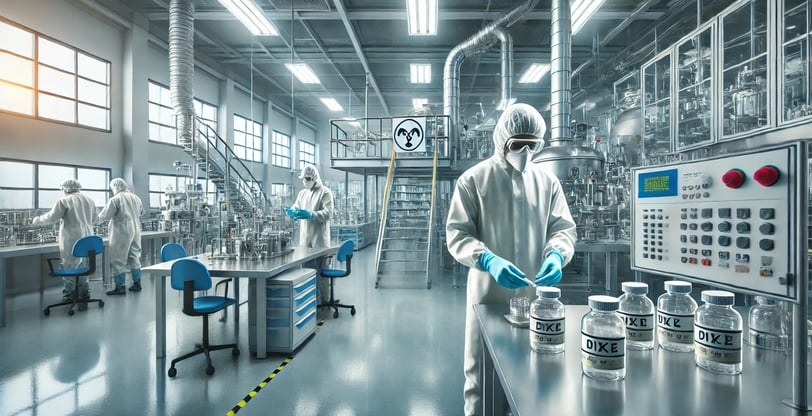Best Practices for Preventing Chemical Exposure Injuries in Pharma Plants
In pharmaceutical manufacturing plants, the handling of chemicals is an integral part of daily operations. However, exposure to hazardous substances can lead to serious health risks for employees, including respiratory issues, skin conditions, and long-term chronic diseases. Implementing best practices for preventing chemical exposure is crucial to ensuring a safe and compliant working environment. Below are key strategies to mitigate risks and protect workers.
1/27/20252 min read


1. Conducting Comprehensive Risk Assessments
Before any chemical is used in a pharmaceutical plant, a thorough risk assessment should be conducted. This involves:
Identifying hazardous chemicals and their potential effects on health.
Evaluating exposure routes such as inhalation, skin contact, and ingestion.
Determining the likelihood and severity of potential exposure incidents.
Implementing necessary control measures based on findings.
2. Implementing Proper Ventilation Systems
An efficient ventilation system is essential to minimize airborne chemical exposure. Pharma plants should install:
Local Exhaust Ventilation (LEV) to capture contaminants at the source.
General ventilation systems to maintain air quality.
Regular maintenance schedules to ensure optimal performance.
3. Providing Personal Protective Equipment (PPE)
Equipping workers with the appropriate PPE can significantly reduce the risk of exposure. Essential PPE includes:
Respirators and masks for airborne particles and vapors.
Chemical-resistant gloves to protect hands.
Safety goggles or face shields to prevent eye exposure.
Protective clothing to minimize skin contact.
4. Training and Education for Employees
Regular training programs should be conducted to educate employees on:
Proper handling and storage of hazardous chemicals.
Emergency response procedures in case of exposure incidents.
The importance of PPE usage and its correct application.
Recognizing early signs of chemical exposure.
5. Proper Chemical Storage and Labeling
Safe storage practices help prevent accidental exposure and spills. Pharma plants should:
Use clearly labeled containers indicating chemical hazards.
Store chemicals in designated areas with appropriate containment measures.
Follow Material Safety Data Sheet (MSDS) guidelines for storage conditions.
Implement inventory tracking to monitor chemical usage and stock levels.
6. Establishing Emergency Response Procedures
Despite preventive measures, accidental exposure can still occur. Having a robust emergency response plan in place is critical, including:
Readily accessible eye wash stations and emergency showers.
First aid protocols tailored for chemical exposure incidents.
Emergency contact information displayed in all work areas.
Regular emergency drills to ensure employee preparedness.
7. Regular Monitoring and Health Surveillance
Continuous monitoring of workplace air quality and employee health is vital to detect early signs of exposure. Recommended practices include:
Conducting periodic air sampling and exposure assessments.
Implementing biological monitoring for high-risk chemicals.
Encouraging workers to report symptoms or concerns promptly.
8. Promoting a Safety-First Culture
A proactive safety culture can prevent chemical exposure injuries by encouraging:
Open communication regarding safety concerns.
Rewarding employees for following safety protocols.
Continuous improvement initiatives to enhance safety measures.
Involvement of all stakeholders in safety planning and execution.
Conclusion
Preventing chemical exposure injuries in pharmaceutical plants requires a comprehensive approach that integrates risk assessments, proper equipment, employee training, and a strong safety culture. By implementing these best practices, pharma companies can create a safe workplace, ensure regulatory compliance, and protect the health and well-being of their workforce.
